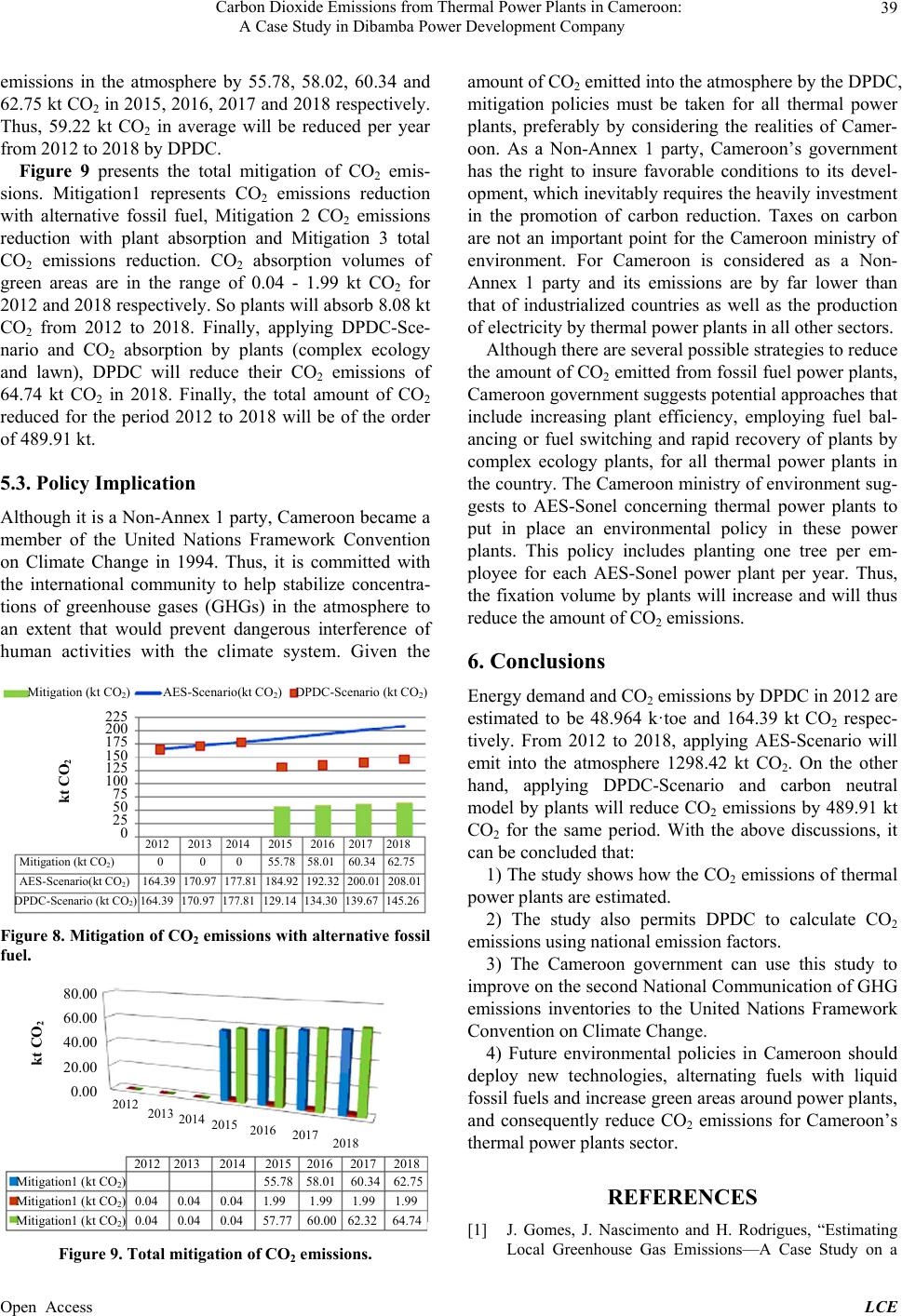
Carbon Dioxide Emissions from Thermal Power Plants in Cameroon:
A Case Study in Dibamba Power Development Company
39
emissions in the atmosphere by 55.78, 58.02, 60.34 and
62.75 kt CO2 in 2015, 2016, 2017 and 2018 respectively.
Thus, 59.22 kt CO2 in average will be reduced per year
from 2012 to 2018 by DPDC.
Figure 9 presents the total mitigation of CO2 emis-
sions. Mitigation1 represents CO2 emissions reduction
with alternative fossil fuel, Mitigation 2 CO2 emissions
reduction with plant absorption and Mitigation 3 total
CO2 emissions reduction. CO2 absorption volumes of
green areas are in the range of 0.04 - 1.99 kt CO2 for
2012 and 2018 respectively. So plants will absorb 8.08 kt
CO2 from 2012 to 2018. Finally, applying DPDC-Sce-
nario and CO2 absorption by plants (complex ecology
and lawn), DPDC will reduce their CO2 emissions of
64.74 kt CO2 in 2018. Finally, the total amount of CO2
reduced for the period 2012 to 2018 will be of the order
of 489.91 kt.
5.3. Policy Implication
Although it is a Non-Annex 1 party, Cameroon became a
member of the United Nations Framework Convention
on Climate Change in 1994. Thus, it is committed with
the international community to help stabilize concentra-
tions of greenhouse gases (GHGs) in the atmosphere to
an extent that would prevent dangerous interference of
human activities with the climate system. Given the
Mitigation (kt CO
2
) AES-Scenario(kt CO
2
) DPDC-Scenario (kt CO
2
)
225
200
175
150
125
100
75
50
25
0
kt CO
2
Mitigation (kt CO
2
) 0 0 0 55.78 58.01 60.34 62.75
AES-Scenario(kt CO
2
) 164.39 170.97 177.81 184.92 192.32 200.01 208.01
DPDC-Scenario (kt CO
2
) 164.39 170.97 177.81 129.14 134.30 139.67 145.26
2012 2013 2014 2015 2016 2017 2018
Figure 8. Mitigation of CO2 emissions with alternative fossil
fuel.
80.00
60.00
40.00
20.00
0.00
kt CO2
2012 2013 2014 2015 2016 2017 2018
Mitigation1 (kt CO2) 55.78 58.01 60.34 62.75
Mitigation1 (kt CO2) 0.04 0.04 0.04 1.99 1.99 1.99 1.99
Mitigation1 (kt CO2) 0.04 0.04 0.04 57.77 60.00 62.32 64.74
2012 2013 2014 2015 2016 2017 2018
Figure 9. Total mitigation of CO2 emissions.
amount of CO2 emitted into the atmosphere by the DPDC,
mitigation policies must be taken for all thermal power
plants, preferably by considering the realities of Camer-
oon. As a Non-Annex 1 party, Cameroon’s government
has the right to insure favorable conditions to its devel-
opment, which inevitably requires the heavily investment
in the promotion of carbon reduction. Taxes on carbon
are not an important point for the Cameroon ministry of
environment. For Cameroon is considered as a Non-
Annex 1 party and its emissions are by far lower than
that of industrialized countries as well as the production
of electricity by thermal power plants in all other sectors.
Although there are several possible strategies to reduce
the amount of CO2 emitted from fossil fuel power plants,
Cameroon government suggests potential approaches that
include increasing plant efficiency, employing fuel bal-
ancing or fuel switching and rapid recovery of plants by
complex ecology plants, for all thermal power plants in
the country. The Cameroon ministry of environment sug-
gests to AES-Sonel concerning thermal power plants to
put in place an environmental policy in these power
plants. This policy includes planting one tree per em-
ployee for each AES-Sonel power plant per year. Thus,
the fixation volume by plants will increase and will thus
reduce the amount of CO2 emissions.
6. Conclusions
Energy demand and CO2 emissions by DPDC in 2012 are
estimated to be 48.964 k·toe and 164.39 kt CO2 respec-
tively. From 2012 to 2018, applying AES-Scenario will
emit into the atmosphere 1298.42 kt CO2. On the other
hand, applying DPDC-Scenario and carbon neutral
model by plants will reduce CO2 emissions by 489.91 kt
CO2 for the same period. With the above discussions, it
can be concluded that:
1) The study shows how the CO2 emissions of thermal
power plants are estimated.
2) The study also permits DPDC to calculate CO2
emissions using national emission factors.
3) The Cameroon government can use this study to
improve on the second National Communication of GHG
emissions inventories to the United Nations Framework
Convention on Climate Change.
4) Future environmental policies in Cameroon should
deploy new technologies, alternating fuels with liquid
fossil fuels and increase green areas around power plants,
and consequently reduce CO2 emissions for Cameroon’s
thermal power plants sector.
REFERENCES
[1] J. Gomes, J. Nascimento and H. Rodrigues, “Estimating
Local Greenhouse Gas Emissions—A Case Study on a
Open Access LCE